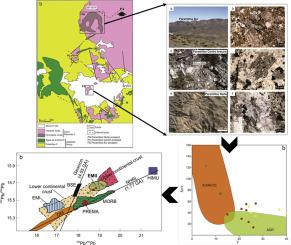Silvia I. Carrasquero, Nora A. Rubinstein, Anabel L.R. Gómez, Massimo Chiaradia, Dénis Fontignie, Victor A. Valencia
2 017
Geoscience Frontiers
The Paramillos de Uspallata mining district located in the backarc region of the Pampean flat-slab segment (28°–33°S) features porphyry-type deposits genetically associated with Middle Miocene volcanics. This mineralizing magmatism comprising hydrothermally altered (sodic-calcic, potassic and phyllic alteration) subvolcanic and pyroclastic rocks of andesite-basaltic andesite and dacite- rhyolite composition with a typical arc signature, represents the eastward broadening of the Farellones arc by ∼17 Ma. Its geochemistry also reveals a residual mineralogy of amphibole ± garnet with limited plagioclase fractionation resulting in an adakitic signal; however, according to the isotopic data collected in our study, the contributions of MASH (melting-assimilation-storage-homogenization) processes in the acquisition of this signal cannot be disregarded.
Both the broadening of the Farellones arc and its residual mineralogy - typical of relatively deep magmatic chambers - are consistent with a slab shallowing and outcoming crustal thickening setting. This tectonic scenario could be interpreted as a result of an early effect of the Juan Fernandez Ridge collision that was further to the north by ∼17 Ma. Our findings suggest that magmas were fertile for porphyry type deposits during the early stages of the slab shallowing.
Both the broadening of the Farellones arc and its residual mineralogy - typical of relatively deep magmatic chambers - are consistent with a slab shallowing and outcoming crustal thickening setting. This tectonic scenario could be interpreted as a result of an early effect of the Juan Fernandez Ridge collision that was further to the north by ∼17 Ma. Our findings suggest that magmas were fertile for porphyry type deposits during the early stages of the slab shallowing.
http://www.sciencedirect.com/science/article/pii/S1674987117301755

